Most farmers develop excellent crop production plans each year, including strategies for pest management, fertilization, and tillage. Producers then manage these practices within the farm’s physical and financial resources. A grain marketing plan works with a farm’s production plan to identify a farmer’s specific price objectives as the production and/or storage season progresses. The marketing plan also identifies strategies available to achieve these specific price objectives.
Grain price seasonality in the U.S. generally results in low grain prices during the fall harvest period due to abundant supply. The uncertainty of early summer tends to allow plenty of price fluctuation and volatility, which usually causes grain prices to reach their annual high levels. Grain prices follow a seasonal pattern as depicted by graph A from Chad Hart, Iowa State University Outreach and Extension.
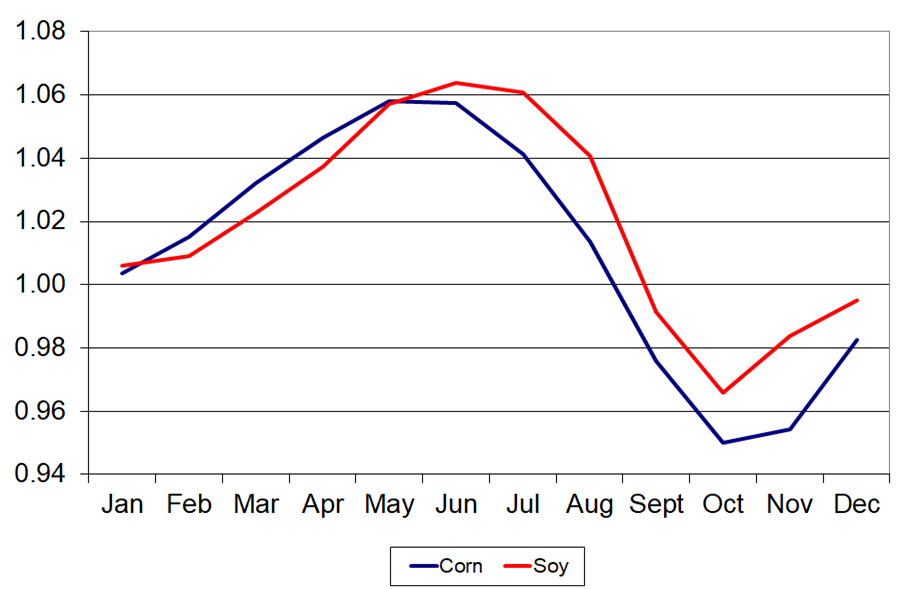
Nine years out of ten, corn prices bottom during fall harvest. Further, local basis is also weakest at harvest. Prices, and local basis, begin to strengthen when harvest is complete to encourage grain to be sold out of storage. Prices continue to move higher during February into March as markets are trying to “buy” acres of production. May through July tend to be weather influenced markets, with significant market moves able to occur in both directions in response to developing drought, a coming storm front, planting progress reports, and many other events. Nine years in ten it is a good idea to have your stored grain and any pre-harvest marketing completed by the fourth of July.
Soybean prices are also usually lowest at fall harvest. Similar to corn, prices and basis tend to strengthen after harvest. However, the soybean market is dramatically affected by the South American soybean harvest starting in February. This reduces the likelihood of winter price rallies in the U.S. market unless South America has a smaller than average crop. Prices begin to climb in the United States when the South American crop size is known and U.S. planting season nears. Spring and summer prices focus on U.S. crop conditions. All of these factors work together to create soybean prices which typically peak in mid to late summer and trail off into harvest. The post-harvest price increase is not as dramatic for soybeans as corn price unless South America is experiencing weather related issues.
As Chad Hart, Iowa State University Extension Economist, noted in his market outlook presentation at the beginning of 2021 and in graph B, the price patterns in 2020 followed the one in ten-year pattern of increasing as harvest time began. “The global pandemic (COVID-19) caused a market disruption in March through May, reducing prices of most agricultural commodities. Expanding drought and a weakening US dollar caused prices of corn and soybeans to increase. A weak US dollar makes US exports cheaper to other countries and can increase the amount of commodities we export. Dry conditions in South America reduced the size of the South American crops, adding strength to US prices. As South America began their harvest, US soy prices dropped slightly in this graph. The last time we had a marketing year with this price pattern was 2012, a year of drought conditions in the US.”
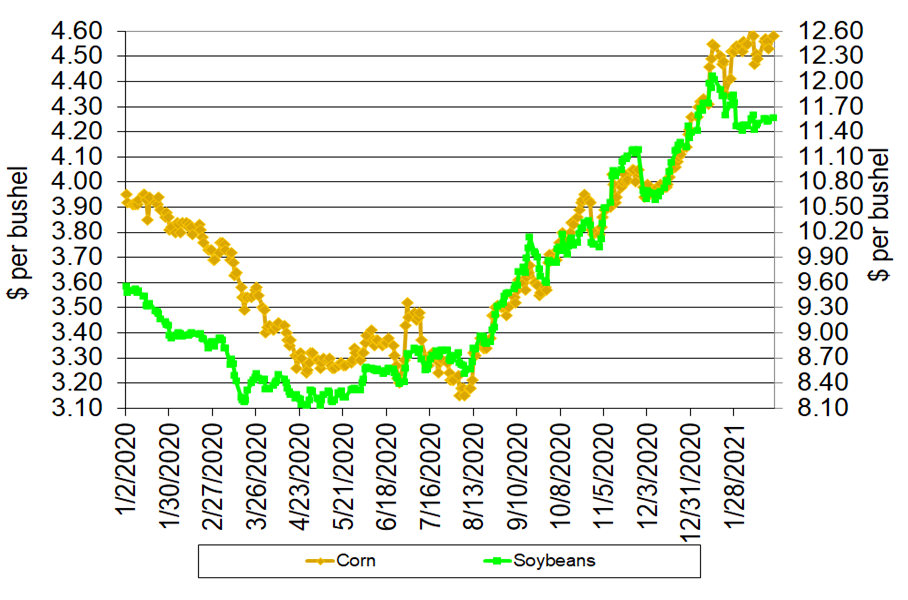
Seasonal price patterns are just one of several major factors that influence the grain marketing plan. Understanding normal price patterns allows a farm to make more informed grain marketing decisions and helps them notice abnormal pricing conditions and opportunities.
Contributing Authors:
- Steve Okonek, Extension Agriculture Educator, Trempealeau County
- Josh Kamps, Extension Agriculture Educator, Lafayette County
- Scott Reuss, Associate Professor, Extension Agriculture Agent, Marinette County
References:
- Hart, C. (2021). Ag Market Outlook, 2021. Iowa State University Extension and Outreach/Department of Economics. Retrieved from http://www2.econ.iastate.edu/faculty/hart/presentations2021.html
- Hart, C., Johnson, S., Kordick, E. (2020). Iowa Commodity Challenge Marketing Tools Workbook. Iowa State University Extension and Outreach and Iowa Farm Bureau. Workbook (https://www.extension.iastate.edu/agdm/info/icc/iccbook.pdf) Retrieved from https://www.extension.iastate.edu/agdm/info/icc.html.
- Reddy, R., Andrews, G., Feuerstein, M., Fortenberry, R., Glewen, M., Hanson, M., & Vanderlin, J. (2004). AgVentures – Grain Marketing Module. University of Wisconsin – Extension.

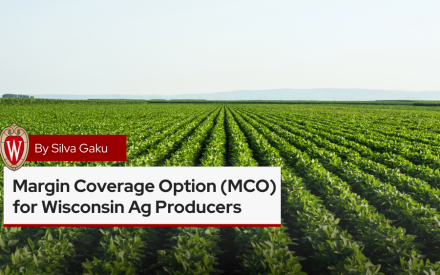 Margin Coverage Option (MCO) for Wisconsin Ag Producers
Margin Coverage Option (MCO) for Wisconsin Ag Producers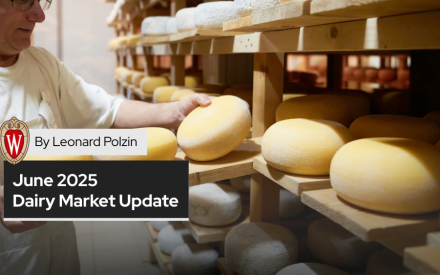 Dairy Market Dynamics and Domestic Constraints: A Dairy Sector Assessment as of June 2025
Dairy Market Dynamics and Domestic Constraints: A Dairy Sector Assessment as of June 2025 U.S.–Canada Dairy Trade Relationship (2025–Present)
U.S.–Canada Dairy Trade Relationship (2025–Present)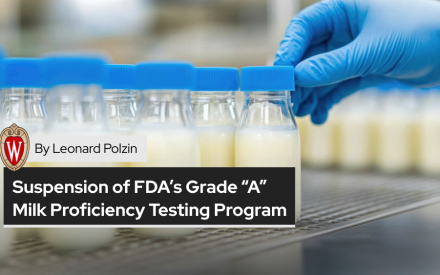 Suspension of FDA’s Grade “A” Milk Proficiency Testing Program – A Comprehensive Analysis
Suspension of FDA’s Grade “A” Milk Proficiency Testing Program – A Comprehensive Analysis


